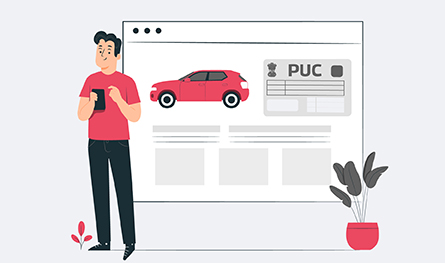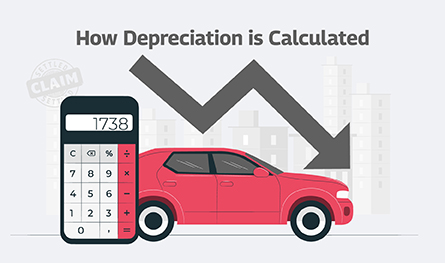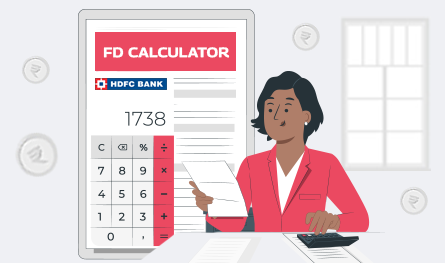How to Check Vehicle PUC Certificate Status Online in India?


- What is a Car or Bike PUC Certificate?
- What is the Importance of a PUC Certificate?
- Checking Pollution (PUC) Status of Vehicle (Car and Bike)
- How to get a PUC Check done?
- What is the Validity of PUC Certificate for Bike or Car?
- What Does a PUC Certificate Contain?
- Benefits of Getting PUC Certificate for Car and Bike?
- Process to Obtain a PUC Certificate Online and Offline for Bike or Car?
- What are the PUC Certificate Charges?
- Penalties for driving a vehicle with no PUC Certificate
What is a Car or Bike PUC Certificate?
A Pollution Under Control (PUC) Certificate is generated after ensuring the parameters of smoke emitted by a vehicle via Air Pollution Index (API). Every vehicle manufacturer provides the API in vehicles which can be used to check the PUC. PUC is issued by PUC Centers or Pollution Check Points that are available all over the country after ensuring that the emission/pollution levels of your bike/car is within the legally permitted limit. In this blog, we are discussing the ways through which you can find out how to check your vehicle’s PUC certificate online. Read on to know more.
What is the Importance of a PUC Certificate?
The PUC regulation was initiated by the government to ensure that the different vehicles running on the roads release minimum emissions and keep pollution levels within the prescribed limit. Since vehicles serve as a major contributor of pollution in the air, government has made it obligatory for two-wheelers and four-wheelers to have PUC check to identify the vehicles that are in poor condition, and which releases the maximum emission.
This was a very important step initiated by the government that helped in curbing the carbon footprints in India. Every Indian citizen must follow the pollution check rules and keep PUC certificate of their vehicles with them while driving a two-wheeler or four-wheeler on the roads of India.
Checking Pollution (PUC) Status of Vehicle (Car and Bike)
Checking the status of your vehicle’s PUC online is not a difficult task. All you need is to follow some steps as stated below and you can easily check the pollution status of your car/bike online.
Here are the steps to follow to check vehicle pollution status:
- Visit the page of VAHAN website by logging in to https://vahan.parivahan.gov.in/puc.
- Now, go to tab of PUC Certificate on the main page menu.
- Once the page opens, you will have to submit your bike’s or car’s registration number.
- You also need to submit the final five characters of your vehicle’s chassis number.
- Now, you will have to complete the captcha.
- And finally, all the details related to the PUC Certificate of your bike/car can be seen in the page that opens. Here, you can also check the validity and readings of the PUC certificate.
Thus, as you can see above, it is very simple to get the details of your VAHAN PUC online. You can follow the simple process in the VAHAN website and get all the significant information.
How to get a PUC Check done?
PUC check is an important consideration for your vehicle to meet emission requirements to comply with government regulations. Here are the steps to get a PUC check done on your vehicle:
- Visit PUC centers available at petrol pumps as well as there are authorized centers across India
- You must carry the documents required like your vehicle RC and Driving Licence
- To initiate the process, the operator at the PUC center will set the equipment up to check the emission of your vehicle by connecting the testing tool to your car’s exhaust pipe
- In the case of petrol-run vehicles, the emission is measured while the engine is revved. For diesel-run vehicles, the emission is measured while the engine is idle
- Once the testing is done, the operator will issue a certificate in case the emissions are within the permissible limit
- If the vehicle fails in terms of prescribed emission levels, you need to get it repaired as required and take a retest
- The PUC of a vehicle stays valid for 1 year in case of new vehicles. After one year, the vehicle PUC should be checked every 6 months
- There is a nominal fee charged for PUC checking as per the vehicle type
- It is important to carry PUC certificates while driving your car on Indian roads to avoid getting fined
What is the Validity of PUC Certificate for Bike or Car?
Once you get the pollution certificate for your bike, it remains valid for one year’s time. However, this is in case of new vehicles, be it a two-wheeler or four-wheeler. After the termination of the initial one year’s time, regular PUC tests of your vehicle is required to be done in every six months in most states of the country. For vehicles that are old, regular PUC checking has to be done as per the norm of the state.
Validity of PUC Certificate in Delhi?
In some cities like New Delhi, the PUC test interval is of three months, so you need to get a PUC done in every three months. For rest of the Indian states, the PUC interval is six months and accordingly, you can get the PUC done.
What Does a PUC Certificate Contain?
Here are the various information available on a PUC certificate:
- Serial number of PUC certificate
- Car registration number
- Start and expiry date of PUC certificate
- Reading of the emission test
Benefits of Getting PUC Certificate for Car and Bike?
Getting a PUC Certificate for bike offers several benefits including:
- By getting the PUC certificate for your vehicle, you can help in conserving the environment.
- PUC certificate help you to know the condition of your car. You will come to know if your car is in good condition or needs servicing.
- By getting PUC certificate of your vehicle, you can abide by the Motor Vehicle Act, 1988 of the government of India.
- The document of PUC certificate is needed in case you want to buy or renew your car insurance policy.
Process to Obtain a PUC Certificate Online and Offline for Bike or Car?
Online Process:
Obtaining a pollution certificate online is easy from any of the PUC centers or from the RTO near you.
Here are the steps to follow:
- Visit the nearest PUC test center approved by government
- The PUC operator will examine the emission levels of your vehicle
- Now pay the fee for the test to the center operator
- Once your application is submitted, the operator will issue your online PUC certificate
Offline Process:
Here are the steps to follow:
- Visit the nearest PUC testing center
- Let the center operator inspect your vehicle to check its emission levels
- Now pay the required fee (which is generally within Rs.100) to the operator
- PUC certificate will be issued
What is the permissible level of emission for a PUC Certificate for new cars?
Every new car owner must have a PUC certificate for their new car as per the Motor Vehicle law of India. It is an obligatory need to drive a car on Indian roads. Here are the permissible emission level details:
| Vehicle type | Hydrocarbon (PPM) | Carbon monoxide (%) |
|---|---|---|
| BS4 and BS6 cars (GNG/LPG) | 200 | 0 |
| BS6 and BS4 cars (petrol) | 200 | 0 |
What is the permissible level of emission for a Pollution Certificate for new bikes?
Like cars, every new bike also needs to have a pollution certificate as per the Motor Vehicle Laws of India. Here are the permissible emission level details:
| Vehicle type | Hydrocarbon (PPM) | Carbon monoxide (%) |
|---|---|---|
| BS6 two/three-wheeler vehicles (GNG/LPG) | 200 | 1 |
| BS6 petrol two/three-wheeler vehicles | 200 | 1 |
What is the permissible level of emission for a PUC Certificate for diesel vehicles?
The emission checking of diesel engines is dissimilar from that of petrol ones as mentioned below:
| Vehicle type (naturally aspirated and turbocharged diesel engine) | Hydrocarbon (PPM) | Carbon monoxide (%) |
|---|---|---|
| BS4 diesel vehicles | 50 | 2 |
| Pre-BS4 diesel vehicles | 65 | 2 |
Permissible Levels of PUC certificate for old vehicles including four, three and two-wheelers
Find below the PUC permissible level norms for old vehicles:
| Vehicle type | Hydrocarbon (PPM) | Carbon monoxide (%) |
|---|---|---|
| BS2 four-wheeler vehicles with petrol engine | 1,500 | 3 |
| BS3 four-wheeler vehicles with petrol engine | 750 | 1 |
| Two-wheeler and four-stroke two and three- wheelers (produced on or before 31 March 2000) | 9,000 | 5 |
| Two-stroke two and three-wheeler vehicles produced after 31 March 2000 | 6,000 | 4 |
| Four-stroke two and three-wheeler vehicles produced after 31 March 2000 | 4,500 | 3.5 |
What are the PUC Certificate Charges?
The PUC test costs a reasonable price and it ranges from INR 60 to INR 100 as per the vehicle type and fuel type of the vehicle.
Is it possible to Renew the PUC Certificate Online?
Renewing a PUC certificate online is not possible as it requires the vehicle’s presence for the emission test. So, you have to take your vehicle physically to the testing center to get the process done.
Are there any RTO-approved PUC Centres? How to find them?
Yes, there are many RTO-approved PUC centers across India. To find their location, you can visit the online portal of Parivahan and check for the PUC center list.
Penalties for driving a vehicle with no PUC Certificate
As per India’s Motor Vehicles Act, it is mandatory to have a PUC Certificate to drive freely on Indian roads. There are strict penalties for candidates not adhering to these rules u/s 190 (2). As per the new modifications in the challans, the penalty for not having a PUC Certificate is INR 10,000. However, the penalties may vary from one state in India to another.

Author Bio
Paybima Team
Paybima is an Indian insurance aggregator on a mission to make insurance simple for people. Paybima is the Digital arm of the already established and trusted Mahindra Insurance Brokers Ltd., a reputed name in the insurance broking industry with 17 years of experience. Paybima promises you the easy-to-access online platform to buy insurance policies, and also extend their unrelented assistance with all your policy related queries and services.
Other Motor Insurance Products
Latest Post
So, you’ve crossed the fabulous 60 mark. Retirement may be on the cards, your kids might be off doing their own thing, and suddenly your knees are making more noise than your WhatsApp notifications. Welcome to the senior citizen club.
Now let’s talk about something most of us tend to postpone until a doctor gives us a reality check: health insurance. If you are wondering whether buying health insurance after 60 makes sense, the answer is a loud and clear yes. This article will cover everything you need to know about it, how it makes sense, how it differs from health insurance for young adults, and what you need to look out for when checking for medical insurance above the age of 60.

.png)
April 2 is observed as World Autism Awareness Day and there is no better way to observe the day than to raise awareness of this condition and to promote kindness towards autistic people. Read on to know more.


Car depreciation implies the difference between the cost of a car at the time of buying the car and when you sell it. A car insurance claim amount is determined by the car depreciation rate. The car depreciation rate is the reduction in the value of your car over its lifespan caused by wear and tear.


Fixed Deposits (FDs) are one of the safest ways to grow your savings. HDFC Bank offers attractive FD interest rates, allowing you to earn guaranteed returns on your investment. But before you invest, it's important to know how much interest you will earn and what your final maturity amount will be.


If you think of life insurance, chances are you are picturing something people buy in their 30s or 40s. But what if you are 65 or older and just getting started? The good news is that you are never too late. Whether you are thinking of easing the financial burden on your family, covering final expenses, or simply leaving behind a legacy, there are life insurance options tailored just for you.
This article will be a guide to life insurance for senior citizens above 65 years, explaining why it is important, the type of insurance options, and how to get the right policy for you.




